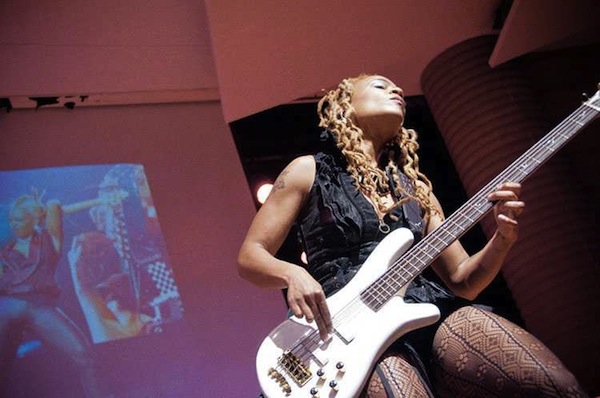
“Black Music Rocks…and Sings, and Raps, and Has an Orchestra”
By Gregory Lucas-Myers, Charles H. Wright Museum of African American History
This past March, I attended “Black Women Rock!” at the Charles H. Wright Museum of African American History. Wearing its title proudly, the evening was filled with rock n’ roll music that expressed the energy, passions, and stories of the ensemble of black women behind every instrument and microphone. There were two drummers, at times alternating and playing together in a series of jam sessions – Gaylynn McKinney was one of them (my apologies to the other drummer, but her identity has been lost to the unreachable depths of my memory).
Black Women Rock! brings the house down at the 2012 edition of the annual talent showcase.
Why do I remember Ms. McKinney, aside from the fact that she put on awesome performances? A few weeks after “Black Women Rock,” I had dinner at the Dirty Dog Jazz Café, a nice little spot in Grosse Pointe, an inner suburb of Detroit. The featured musician that night was Benny Golson, and he was part of a trio for the evening, a pianist and a drummer.
Naturally, that drummer was Gaylynn McKinney.
With this talented woman being able to switch styles from a raucous rock show to an intimate jazz performance, I began to think on the fluidity of genre, how changing just a few things can produce something radically different. Moreover, I began to think on the connection that rock and jazz share in their historic roots, which are firmly intertwined with African American history.
It is common knowledge that these two wholly American musical genres, rock n’ roll and jazz, grew from parts of the African-American experience. As blacks continued to find their collective identity after slavery, they brought their musical styles with them. As time passed, cultures of all creeds began to emulate, share, and take on elements from other sources. Visionaries experimented with blues, country, European classical instrumentation, and traditional African spirituals and rhythms to take everything further, something that still goes on today.
When the term “jazz” comes up, legends such as Miles Davis, Thelonious Monk, and Louis Armstrong immediately spring to mind. For rock, some may be aware enough to name Little Richard and Chuck Barry. But, what about the impact made on rock by James Brown? Giving a rundown on the influence of African Americans on rock is beyond the scope of this piece, but it would not hurt for the name Otis Blackwell to be more well known as a rock legend, or for bands such as Living Colour (whose hit “Cult of Personality” is infectious) to get more credit as greats.
June is Black Music Month, but I wonder…why not expand the definition beyond the important, but typical material of the spiritual and R&B genres? How about electronic music? Sun Ra, Afrika Bambaataa, and a slew of other black DJs, from Detroit and worldwide, have had substantial impact there. We cover classical music, as well, with names such as Joseph Bologne and Charles Dean Dixon. And, though controversial at times, hip hop should not be ignored as a genre defined by the black experience. Beyond the commercial veil is a world of innovative lyricists and beat artists who speak volumes with every word and track. There is a universe of black music to explore, and doing so can only lead to broader experiences outside one’s comfort zone and greater inclusivity.
“Black Women Rock!” is an annual concert event at The Wright, produced with the dedication and support of our partners. For more pictures of this year’s event, information on future events, exhibits, daily black history facts, and more, please visit our homepage at TheWright.org, find us on Facebook at Charles H. Wright Museum, and follow us on Twitter at @TheWrightMuseum.
Recent Content
-
Artsarticle ·
-
Artsarticle ·
-
Artsarticle ·
